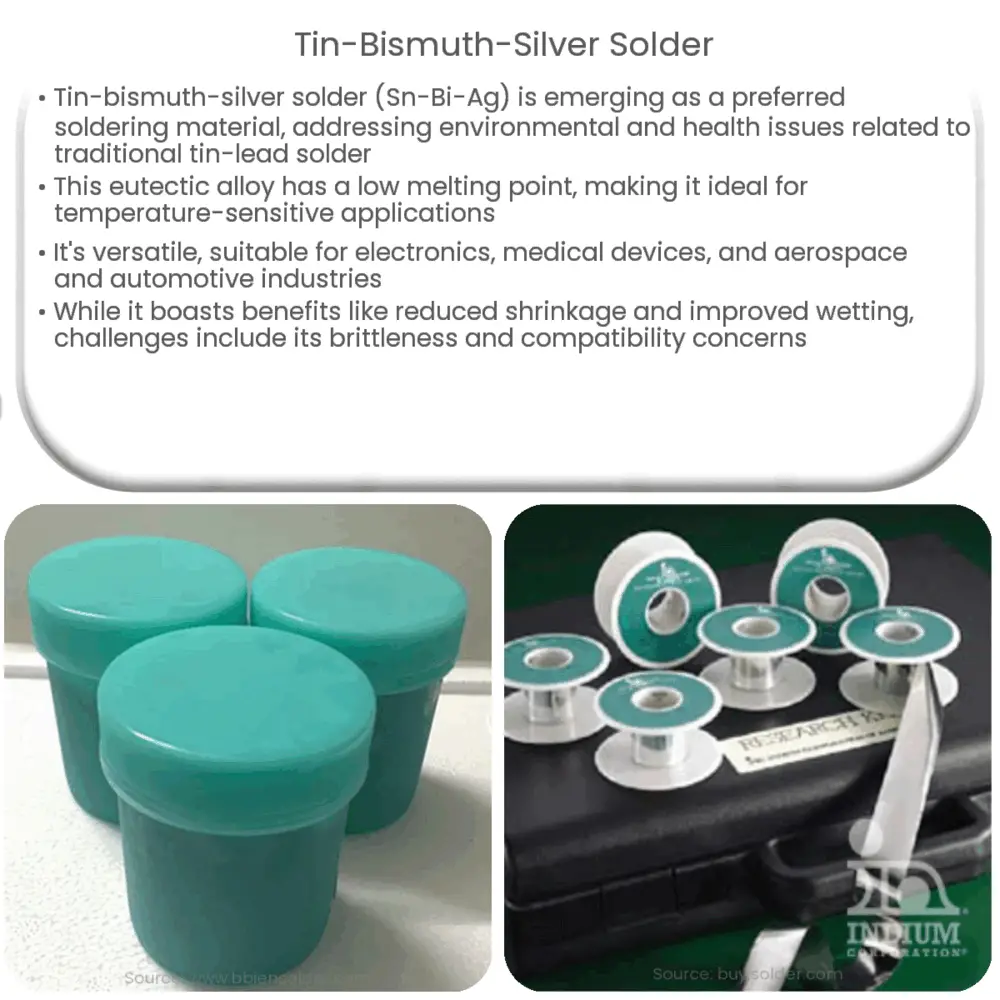Tin-Bismuth-Silver solder is a lead-free, low-melting alloy with enhanced thermal and mechanical properties, ideal for electronics, medical devices, and automotive applications.

Tin-Bismuth-Silver Solder: The Future of Soldering
Introduction
Soldering is a fundamental process in the electronics industry, providing secure and reliable connections between various components. Traditionally, the most commonly used soldering alloy was tin-lead, but recent concerns about its environmental impact and toxicity have led to the development and adoption of new soldering materials. One such alloy is tin-bismuth-silver (Sn-Bi-Ag) solder, which is gaining popularity due to its excellent performance characteristics, reduced environmental impact, and compatibility with lead-free soldering requirements. In this article, we will explore the composition, properties, and applications of tin-bismuth-silver solder.
Composition and Properties
Tin-bismuth-silver solder is a eutectic alloy consisting of three elements: tin (Sn), bismuth (Bi), and silver (Ag). Typically, the composition of this solder is around 42% tin, 57.6% bismuth, and 0.4% silver. This specific composition results in a eutectic alloy, meaning it has a single melting point and solidifies at a uniform temperature, which is approximately 138°C (280°F). This low melting temperature makes it an attractive option for use in temperature-sensitive applications.
Compared to traditional tin-lead solder, tin-bismuth-silver solder offers several advantages. Firstly, it is lead-free, addressing environmental and health concerns associated with lead exposure. Secondly, it has a lower melting point, reducing the risk of thermal damage to components during soldering. Additionally, the inclusion of silver in the alloy enhances its mechanical and thermal properties, improving joint reliability and thermal fatigue performance.
Applications
Tin-bismuth-silver solder is versatile and can be used in a wide range of applications. Some of its most common uses include:
- Electronics Manufacturing: The low melting point and excellent thermal properties of tin-bismuth-silver solder make it suitable for use in the assembly of printed circuit boards (PCBs) and other electronic components. It is compatible with both surface mount technology (SMT) and through-hole soldering processes.
- Medical Devices: The lead-free composition of tin-bismuth-silver solder is particularly important in medical devices, where concerns about lead exposure are especially critical. The low melting point also helps protect sensitive electronic components during assembly.
- Aerospace and Automotive: The enhanced mechanical and thermal properties provided by the silver content in tin-bismuth-silver solder make it a reliable choice for aerospace and automotive applications, where solder joints must withstand harsh environmental conditions and thermal stresses.
Overall, tin-bismuth-silver solder is an innovative soldering material that offers significant benefits over traditional tin-lead solder. Its unique combination of properties makes it a preferred choice for a growing number of industries and applications, contributing to its increasing popularity.
Advantages of Tin-Bismuth-Silver Solder
In addition to the benefits already mentioned, tin-bismuth-silver solder has several other advantages:
- Lower Shrinkage: Compared to other lead-free soldering materials, tin-bismuth-silver solder exhibits lower shrinkage during solidification, reducing the risk of joint defects such as voids and cracks.
- Improved Wetting: Tin-bismuth-silver solder has excellent wetting properties, meaning it can easily spread and adhere to surfaces during the soldering process. This results in strong, high-quality solder joints.
- Reduced Tin Whisker Formation: Tin whiskers are tiny, hair-like filaments that can grow from pure tin surfaces over time, causing short circuits and component failures. The addition of bismuth and silver to the tin in this solder alloy helps suppress tin whisker formation, improving long-term reliability.
Challenges and Limitations
While tin-bismuth-silver solder offers many advantages, it is essential to be aware of some challenges and limitations:
- Brittleness: Bismuth can cause the solder alloy to be more brittle than traditional tin-lead solder. This can result in increased susceptibility to mechanical stresses, making it necessary to handle soldered components with care.
- Compatibility with Other Soldering Materials: Tin-bismuth-silver solder may not be compatible with some existing soldering materials or processes. Careful evaluation and testing are required to ensure compatibility before implementation in a production environment.
- Cost: The addition of silver to the alloy can increase the cost of tin-bismuth-silver solder compared to other lead-free alternatives. However, the performance benefits often justify the increased expense.
Conclusion
Tin-bismuth-silver solder is a promising lead-free soldering material that addresses environmental and health concerns associated with traditional tin-lead solder. Its low melting temperature, improved mechanical and thermal properties, and excellent wetting characteristics make it an attractive option for various applications in the electronics, medical device, aerospace, and automotive industries.
While there are challenges and limitations, such as brittleness and compatibility concerns, tin-bismuth-silver solder’s benefits often outweigh these drawbacks. As the demand for environmentally friendly and high-performance soldering materials continues to grow, tin-bismuth-silver solder is expected to play an increasingly important role in the future of soldering technology.

